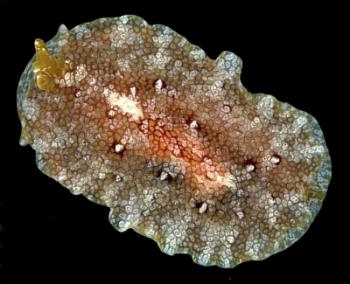
Pleurobranchus albiguttatus
(Bergh, 1905)
Order: NOTASPIDEA
Superfamily: PLEUROBRANCHOIDEA
Family: Pleurobranchidae
DISTRIBUTION
Indo-West Pacific
PHOTO
UPPER RIGHT: Sand Cay in front of Kaala-Gomen, near Koumac, New Caledonia, 20°40'S, 164°19'E, intertidal, with sea grass and living coral, 22 October 1993, 50mm long alive, AM C200579. LOWER RIGHT: Close-up of mantle showing polygonal markings and white triangular markings on dark brown tubercles.
LOWER LEFT: Île Amédée, SW Lagoon, 1m, 21 September 1988, reef crest, under coral rock, AM C156664. PHOTOS: Bill Rudman.
Originally described from Indonesia, and occurring from East Africa to the Great Barrier Reef (personal observations) Gosliner's photograph of a specimen from South Africa (as P. nigropunctatus) is the only other published record of this species. Externally it is easily recognised by the regularly arranged triangular white marks on the inside of dark brown tubercles. The tip of the white triangles point towards the mantle edge. This shading gives the spots the appearance of raised white pointed papillae.
See Pleurobranchus atlanticus which is possibly an Atlantic 'form' or 'sibling species'.
Reference:
• Bergh, L.S.R., (1905). Die Opisthobranchiata. Siboga Expeditie Report, 50: 248pp., Pls 1-20.
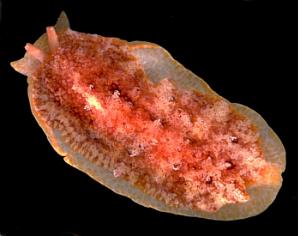
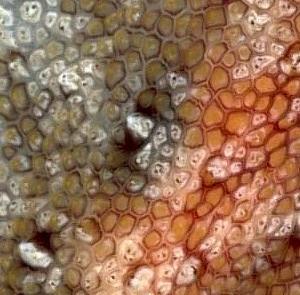
Rudman, W.B., 2000 (October 20) Pleurobranchus albiguttatus (Bergh, 1905). [In] Sea Slug Forum. Australian Museum, Sydney. Available from http://www.seaslugforum.net/find/pleualbi
Related messages
Re: Pleurobranchus albiguttatus from sthn Queensland
March 5, 2009
From: Julie Marshall
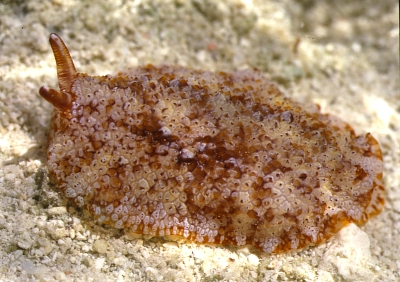
Concerning message #22298:
Dear Bill,
As there are only a few photos of Pleurobranchus albiguttatus from Australia on the forum here are some from Heron Island [Great Barrier Reef. Unlike Gary's animals which were found at 18 m, all the ones I have found have been under coral boulders at the edge of the reef at low tide.
Locality: Heron Island, Intertidal, Queensland, Australia, Pacific Ocean, Nov. 1997, Intertidal. Length: 55 mm. Photographer: Julie Marshall.
Best wishes,
Julie Marshall
juliegm@gmail.com
Marshall, J.G., 2009 (Mar 5) Re: Pleurobranchus albiguttatus from sthn Queensland. [Message in] Sea Slug Forum. Australian Museum, Sydney. Available from http://www.seaslugforum.net/find/22312
Dear Julie,
I'm all in favour of a tiny bit of competitive nationalism if it increases our understanding of species' distribution
Best wishes,
Bill Rudman
Pleurobranchus albiguttatus from sthn Queensland
March 4, 2009
From: Gary Cobb
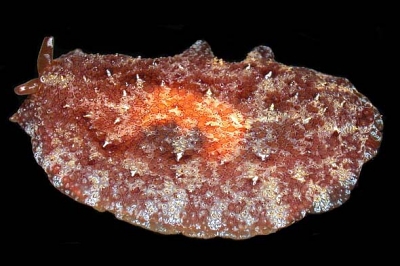
Concerning message #19016:
Hi Bill and everyone!
During todays dives we were turning over coral heads. From under one were two Pleurobranchus albiguttatus. They were dislodged when the turn over occured so they were placed onto the substrate next to the coral head. They move very quick! I have included closeups of the anterior end and mantle.
Locality: Mooloolaba, Sunshine Coast, 18 m, Queensland, Australia, Pacific Ocean, 01 March 2009, Subtidal. Length: 55 mm. Photographer: Gary Cobb.
Cheers
Gary
www.nudibranch.com.au
gary@nudibranch.com.au

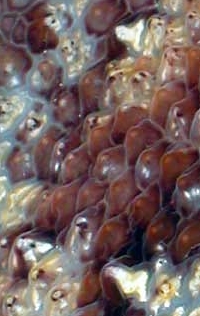
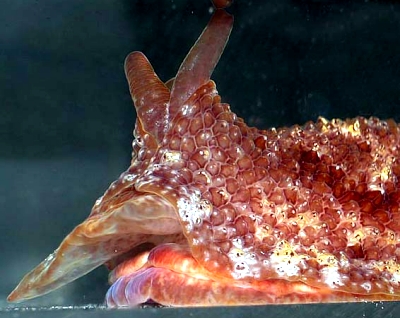
Dear Gary,
Thanks for these nice photos. In your close-up of the mantle you can see the white bands in some of the tubercules which give the species the appearance of radiating white mantle papillae
Best wishes,
Bill Rudman
Re: Pleurobranchus albiguttatus from Reunion Island
December 15, 2006
From: Julie Marshall
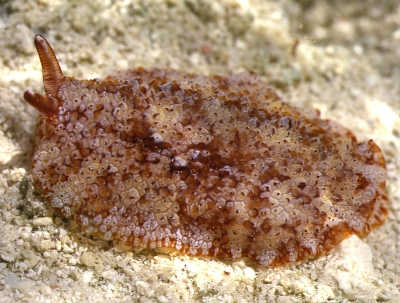
Concerning message #18785:
Dear Bill,
Attached are some photos of Pleurobranchus albiguttatus from Heron Island [Great Barrier Reef] Both animals were found at low tide at the reef crest under dead coral slabs. The first animal, plus close up of its head, was 30 mm in size and the other one, which has a paler pattern, 25 mm.
Locality: Heron Island, Intertidal, Queensland, Australia, Pacific Ocean, 9 January, 1993, Length: 30 mm; 27 September 1992, Length 25 mm. Intertidal. Photographer: Julie Marshall.
Best wishes,
Julie Marshall
juliemarshall@netspace.net.au



Dear Julie,
Thanks for these photos which show the transition from whitish juveniles to brownish adults very well. You can still see the entire orange border in the white animal, and traces of it in the brownish one. In the close-up of the mantle [middle right] you can see that the two darker tubercles with the characteristic white streak are slightly larger than the other tubercles.
Best wishes,
Bill Rudman
Pleurobranchus albiguttatus from Reunion Island
December 13, 2006
From: Hugues Flodrops
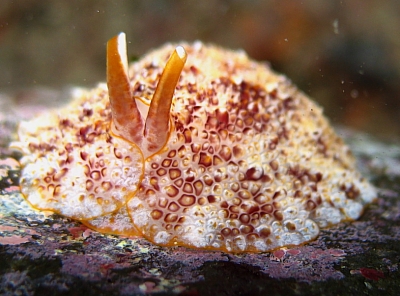
Concerning message #11585:
Dear Bill,
I found under a stone, one other Pleurobranchus, near the where I found P. peroni [message #18662]. My best guess was P. albiguttatus but the pattern colour seemed more red than photo of Marina Poddubestkaia [#11585]. Is Pleurobranchus atlanticus a synonym of this species?
Thank you very much for your time and for the forum.
Locality: Etang-Salé Cote Rocheuse, 0,50 m, Reunion Island, Indian Ocean, 1 december 2006. Length: 40 mm. Photographer: Hugues Flodrops
Regards.
Hugues.
hugues.flodrops@wanadoo.fr
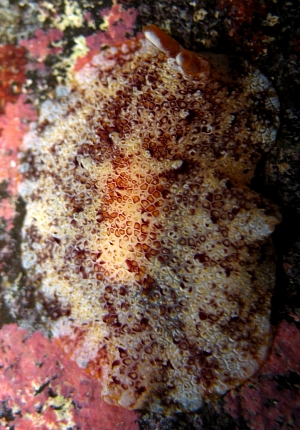
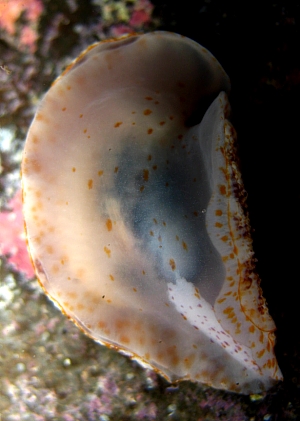
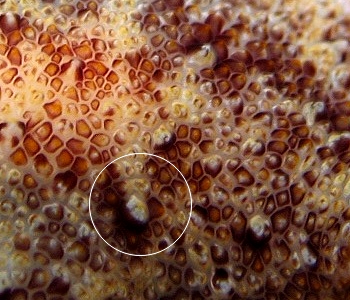
Dear Hugues,
While preparing your message I was surprised to see the treatment of P. atlanticus in the new book by Valdes et al. (2006), Caribbean Sea Slugs. I have discussed this in more detail in a separate mesage [#18917 ]
In my opinion the most distinctive external feature of P. atlanticus is the series of larger tubercles down each side of the midline which each have a white triangular mark on them. This is also the most distinctive external feature on the Indo-West Pacific species P. albiguttatus, and as I say in my earlier comments [#5301] I wouldn't be surprised if P. atlanticus turns out to be the same as P. albiguttatus.
It is interesting that your juvenile has a thin orange mantle border. Anne Dupont [message #5301] sent us a photo of two white juveniles, from the Caribbean, with a thin orange border, which I identified as P. atlanticus, which again reinforces the similarity between these two species. Mind you it is not unique to those two species as I illustrate a similar coloured juvenile of P. peroni on the Fact Sheet for that species.
So to your question about whether P. atlanticus is a synonym of P. alboguttatus, I can say we need to recheck their anatomy, but if I were a gambling man. I think I would put a lot of money on a 'yes' answer.
One interesting feature we can see in your photo [middle right] of the underside of the animal is the intense white elongate patch at the posterior end of the sole of the foot. This is a gland which develops in most species of Pleurobranchus as they reach maturity. I am pretty sure no one has ever studied the function of this gland - another one of the many things we still have to learn about these animals
Best wishes,
Bill Rudman
Pleurobranchus albiguttatus from Mayotte
December 4, 2003
From: Marina Poddubetskaia

Dear Bill,
Here is a record of Pleurobranchus albiguttatus from the Indian Ocean. I found this guy under a stone. Its camouflage was so perfect, that I saw it only when it began to move.
Date: November 11, 2003
Location: Handrema, Mayotte Island, Indian Ocean
Site: Banc Laclocheterie
Depth: 5m
Size: 25mm
Best wishes,
Marina.
nembro@nembro.info
Poddubetskaia, M., 2003 (Dec 4) Pleurobranchus albiguttatus from Mayotte. [Message in] Sea Slug Forum. Australian Museum, Sydney. Available from http://www.seaslugforum.net/find/11585Thanks Marina,
Bill Rudman
Pleurobranchus albiguttatus from Israel
November 16, 2003
From: Michael Levin
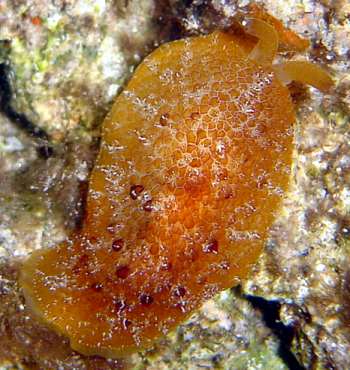
Hi Bill,
I photographed this slug during a night dive at 'The caves' reef, Eilat (Gulf of Aqaba), Red Sea.
At a depth of 10 meter, during mid August 2003.
I wonder if it is Pleurobranchus peroni ?
Thanks ahead,
and thank you for your wonderful forum.
Michael
michael@scubadiving.com
Levin, M., 2003 (Nov 16) Pleurobranchus albiguttatus from Israel. [Message in] Sea Slug Forum. Australian Museum, Sydney. Available from http://www.seaslugforum.net/find/11412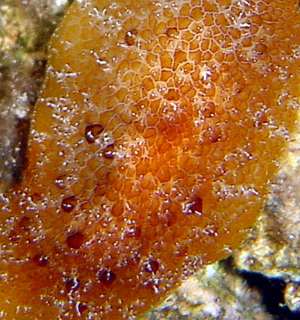
Dear Michael,
It looks quite like P. peroni but the larger dark brown tubercles with a white line down one side are a unique feature found only in Pleurobranchus albiguttatus
Best wishes
Bill Rudman
Pleurobranchus albiguttatus from the Philippines [2]
June 14, 2003
From: Erwin Köhler
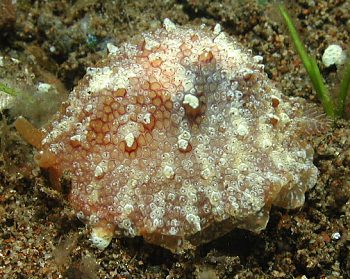
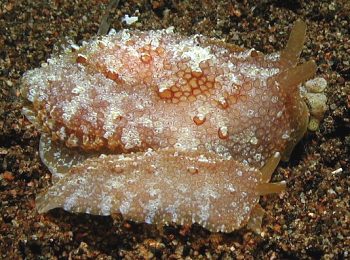
Dear Bill,
Thanks for your identification. Here are some more Pleurobranchus albiguttatus one nightdive later, same data.
Philippines, Negros Oriental Island, divesite "Dauin", nightdive.
length 49 and 35mm
Depth: 7m
Date: 08 May 2003
Cheers,
Erwin
Erwin@Philippine-Sea-Slugs.com
Köhler, E., 2003 (Jun 14) Pleurobranchus albiguttatus from the Philippines [2]. [Message in] Sea Slug Forum. Australian Museum, Sydney. Available from http://www.seaslugforum.net/find/10162Thanks Erwin,
Bill Rudman
Pleurobranchus albiguttatus from the Philippines
June 2, 2003
From: Erwin Koehler

Dear Bill,
Here is one more from my recent trip to the Philippines, Negros Oriental Island, divesite "Dauin", nightdive.
data:
length 42mm
depth 7m
date 07 May 2003
Cheers,
Erwin
Erwin@Philippine-Sea-Slugs.com
Koehler, E., 2003 (Jun 2) Pleurobranchus albiguttatus from the Philippines. [Message in] Sea Slug Forum. Australian Museum, Sydney. Available from http://www.seaslugforum.net/find/10111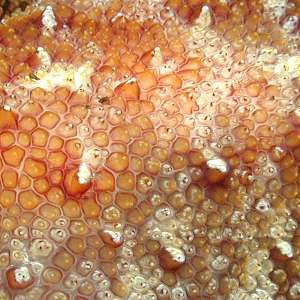
Dear Erwin,
This is Pleurobranchus albiguttatus. I've included a close-up to show how the apparent white pointed papillae on the mantle are an illusion. They are in fact just a triangular mark along one side of some of the rounded brown tubercles.
Best wishes,
Bill Rudman
Pleurobranchus albiguttatus – laying eggs
January 7, 2003
From: W.B. Rudman
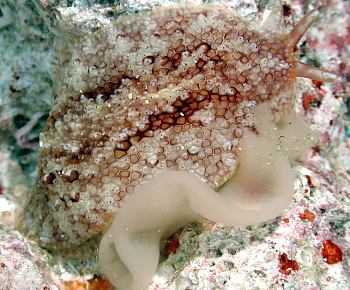
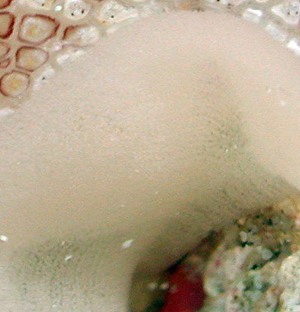
Here is a photo record by Ian Hutton from Lord Howe Island, of Pleurobranchus albiguttatus – laying eggs.
Location: Neds Beach.
Bill Rudman
Rudman, W.B., 2003 (Jan 7) Pleurobranchus albiguttatus – laying eggs. [Message in] Sea Slug Forum. Australian Museum, Sydney. Available from http://www.seaslugforum.net/find/8808Pleurobranchus albiguttatus from Phoenix Ids
October 24, 2002
From: Mary Jane Adams
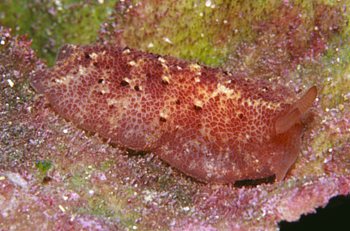
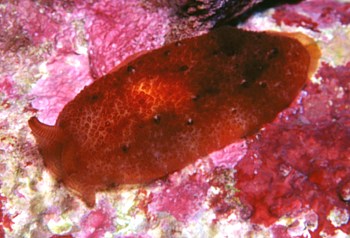
Hi Bill,
I found three Pleurobranchus peroni congregating under a rock on a coral reef slope on Manra Island, Phoenix Group in the Central Pacific. One of them escaped while I was photographing these two. The can crawl surprisingly fast! They were all about 25 mm long.
Divesite: Northern Lee, Depth: 15 meters, Length: about 25mm,
Date: June 15, 2002
Best regards,
Mary Jane
divepng@yahoo.com
Adams M.J., 2002 (Oct 24) Pleurobranchus albiguttatus from Phoenix Ids. [Message in] Sea Slug Forum. Australian Museum, Sydney. Available from http://www.seaslugforum.net/find/8246Thanks Mary Jane,
This is Pleurobranchus albiguttatus. It is quite similar to P. peroni in appearance but has characteristic dark brown V-shaped marks, each filled with white, which look like little pointed papillae.
Best wishes,
Bill Rudman
Pleurobranch from Saudi Arabia
July 24, 2002
From: John Chuk


Dear Bill,
Here is another specimen I'm not sure of. This one is a pleurobranch that was photographed in the Red Sea at 'Nurses' dive site (near Amq, about 400km south of Jeddah) on December 17th, 1992.
The specimen measured 30mm in length and was found at night on the reef flat at a depth of 1.5m. The notum consists of low tubercles and has a mottled brown pattern. When I first looked at the slides I thought the specimen had white filamentous processes on the notum but close observation reveals that these are simply triangular white patches on the sides of some of the tubercles. I have attached a close up image of a portion of the notum showing these white spots.
Could this be a form of Pleurobranchus albiguttatus?
John Chuk
jchuk@giant.net.au
Chuk, J., 2002 (Jul 24) Pleurobranch from Saudi Arabia. [Message in] Sea Slug Forum. Australian Museum, Sydney. Available from http://www.seaslugforum.net/find/7584Dear John,
It certainly looks like Pleurobranchus albiguttatus. The tricky white traingular marks are certainly a hallmark of this species.
Best wishes,
Bill Rudman
